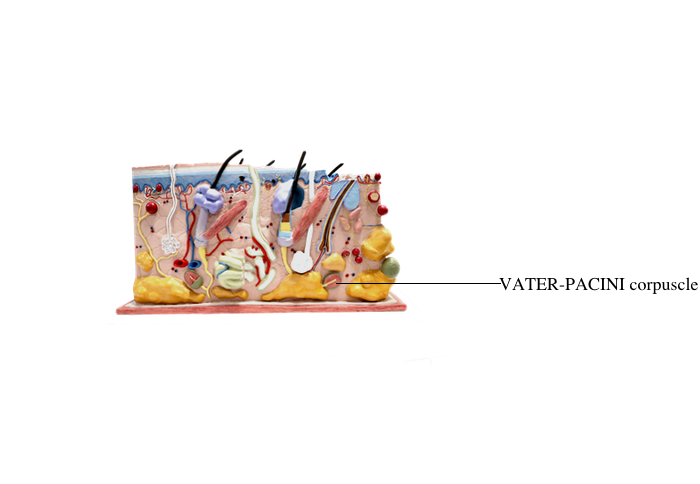Main Model

Anterior : VATER-PACINI corpuscle

Sensory Receptors of the Skin
Sensory receptors are specialized neurons and epithelial-like cells that receive and convert a physical stimulus into an electrical signal transmitted to the central nervous system.
There are three general categories of sensory receptors:
1. Exteroceptors, that provide information about the external environment.
2. Proprioceptors, located in muscles (such as the muscle spindle), tendons, and joint capsules and provide information about the position and movement of the body.
3. Interoceptors, that provide sensory information from the internal organs of the body.
The classification of sensory receptors of the skin is based on the type of stimulus:
1. Mechanoreceptors respond to mechanical deformation of the tissue or the receptor itself (for example, stretch, vibration, pressure, and touch).
There are four primary mechanoreceptors in human skin:
1. Merkel disk.
2. Meissner corpuscle.
3. Ruffini ending.
4. Pacinian corpuscle.
The first two are located at the epidermal-dermal junction; the other two are located in the deep dermis and hypodermis.
Meissner corpuscle, Ruffini ending, pacinian corpuscle, and Krause end bulb are encapsulated receptors. Krause end bulb is a thermoreceptor found only in specialized regions.
The nerve ending of the Merkel disk mechanoreceptor discriminates fine touch and forms a flattened discoid structure attached to the Merkel cell. Merkel cells are found in the stratum basale of the epidermis of the fingertips and lips.
The Meissner corpuscle, or tactile corpuscle, is found in the upper dermis, bulging into the epidermis. They are found primarily in the fingertips and eyelids. This receptor is well suited for the detection of shape and texture during active touch.
The Ruffini ending, or bulbous corpuscle, is located in the deep dermis. It detects skin stretch and deformations within joints. They also provide feedback when gripping objects and controlling finger position and movement (for example, when we use the computer keyboard).
The pacinian corpuscle is found in the deep dermis and hypodermis. It responds to stimuli of deep, transient pressure and high-frequency vibration. They are found in the bone periosteum, joint capsules, pancreas, breast, and genitals.
2. Thermoreceptors respond to a temperature stimulus, either warmth or cold. The Krause end bulb is encapsulated but is not a mechanoreceptor. It is a thermoreceptor that detects cold. Krause end bulbs are found in the conjunctiva of the eye, in the mucosa of the lips and tongue, and in the epineurium of nerves. They are also found in the penis and the clitoris (hence, the name of genital corpuscle).
3. Nociceptors respond to pain stimuli. The simplest form of a pain detector are the free nerve endings. They derive from the dermal nerve plexus, supplied by cutaneous branches of the spinal nerves. Sensory nerve fibers extending toward the skin surface, shed their myelin sheaths before branching as naked axons between collagen fibers, forming dermal nerve endings, or within the epidermis, as epidermal nerve endings.
The very sensitive peritrichial nerve endings are wrapped around the hair follicle just under the sebaceous glands. The myelinated portions of the nerve endings form a palisade of naked terminals along the external root sheath of the hair follicle, surrounded by circumferential terminals. Peritrichial nerve endings are stimulated when the hairs bend.
The perception of pain is associated to acute inflammation, one of the classical responses to tissue injury. Injured cells release chemical mediators, including substance P, acting on local blood vessels and nerve endings. Substance P triggers the degranulation of mast cells, histamine in particular, that enhances vascular dilation and plasma leakage, thereby causing edema in the injury surrounding area.
Hyperemia accounts for the triple response of Lewis when a line is made on the skin with a pointed object: flush (capillary dilation), flare (redness spreading because of arteriolar dilation), and wheal (localized edema). The triple response develops between 1 to 3 minutes.
In summary, the nociceptive receptors (the pain detectors) are found near the skin surface. Merkel disks and Meissner corpuscles, fine mechanoreceptor, are located at the epidermal-dermal junction so they can detect gentle touch. Pacinian corpuscles and Ruffini endings, the large encapsulated mechanoreceptors, are found in the deep dermis and hypodermis and respond to transient deeper touch.